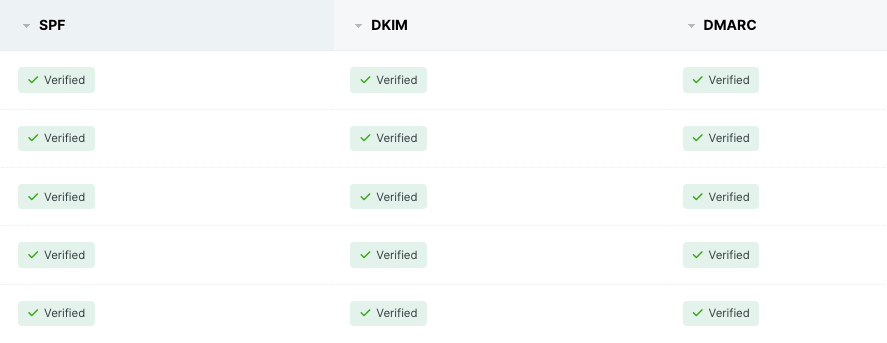Do you know what DKIM, SPF and DMARC are? They are used by email service providers to authenticate the sender and determine whether emails end up in the recipient's priority mailbox or in the spam. Indeed, many providers have sensitive spam filters that react if the necessary authentication is missing.
If you follow the email marketing scene and phenomena, you may have already heard that Gmail is updating its sender requirements in early 2024. The DMARC change means that from February 2024, in addition to DKIM and SPF, Gmail will require DMARC records to be installed to secure emails from abuse and authenticate the sender. DMARC is not new per se, but the installation of records has been voluntary until now.
Sound technical? In practice, the change is welcome as it will reduce the amount of spam. It will make it more likely that identified senders will get their messages through, rather than being blocked or lost in the spam. So good news for email marketers!
In this article you will find:
- Letter combinations explained
- Spam in a nutshell
- What will change in February 2024?
- How will DMARC make the life of an email marketer easier?
Letter combinations explained
Instead of DKIM, SPF, and DMARC, we can also talk about domain settings for short.
- DKIM (DomainKeys Identified Mail): improves the security of email messages by identifying the sender of incoming email.
- SPF (Sender Policy Framework): prevents others from sending emails on your behalf.
- DMARC (Domain-Based Message Authentification, Reporting, and Conformance): complements DKIM and SPF and ultimately decides what to do with the message.
Spam in a nutshell - what the protection measures are there for
Spam and phishing attempts are unfortunately familiar to everyone: emails promising a quick fix, selling dubiously cheap electronics, or enticing you to give up personal identification information such as passwords and IDs.
Often the scams are disguised to resemble familiar and trustworthy institutions such as the Post Office, the tax authorities, or the bank. Fortunately, in the majority of cases, these messages end up in the spam folder and are deleted, but increasingly scammers are also approaching their targets via social media or SMS.
Even if your intentions are honorable and you're not identified as a spammer, your emails will be undermined by certain elements that can resemble deceptive marketing and spam: the use of caps lock and exclamation marks in headlines, a sense of urgency and an adult theme in content, and of course, missing DMARC records in domain settings. The lack of records makes it difficult to verify the sender and often results in messages being flagged as spam.
What will change in February 2024?
In February, Gmail requires the DMARC protocol to be set in addition to the DKIM and SPF settings. This is intended to make emails more secure, for example by trying to reduce phishing and prevent the falsification of sender information.
In practice, DMARC helps to protect the domains of email senders against email abuse, so that only genuine messages can be sent from their domains. Its purpose is to define how messages sent under a particular domain name should be handled. It also indicates which authentication methods must be passed in order to deliver the message in question. DMARC therefore acts as a form of additional security.
However, sender authentication, i.e. setting up DMARC records in the newsletter system, is relatively straightforward and changes take only a few minutes to be made by technical support.
Ideally, a knowledgeable service provider will provide guidance and support for setting up the records, as their absence can have a dramatic impact on the delivery of your newsletters.

In LianaMailer, you can easily check whether your domain settings are correct yourself.
How will DMARC make the life of an email marketer easier?
As mentioned, DMARC is a welcome change in the email marketing landscape. Here are a few reasons why:
- Building trust and maintaining your reputation: with DMARC, service providers ensure that the emails you send are genuine. This verification reinforces trust and leads to a better reputation for the sender. The reputation of the sender is the rating that email service providers give to your IP address.
- Improved deliverability: because DMARC helps ensure correct routing, emails are more likely to reach their destination and avoid the spam folder.
- Improved customer satisfaction: trusted and authenticated emails improve the user experience and are likely to increase customer satisfaction.
How are DKIM, SPF, and DMARC taken into account in LianaMailer?
The newsletter tool LianaMailer's deliverability is taken care of in many different ways. For example, we guide and help you to set the necessary domain settings for each of our customers so that the deliverability of your newsletters is not compromised. Our customers can also easily check whether the settings are in order themselves.
LianaMailer's top-notch delivery reliability is the result of our skilled team and quality services, and we are constantly working on product development and security.



![How to Get Started with Podcasts? [Infographic]](/media/blog/podcast-article/cache/starting-your-own-podcast-article-cover-378x214,c.png)